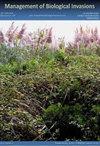Development of a surveillance species list to inform aquatic invasive species management in the Laurentian Great Lakes
IF 1.2
4区 环境科学与生态学
Q3 BIODIVERSITY CONSERVATION
引用次数: 7
Abstract
In an effort to harmonize multi-jurisdictional surveillance and detection of aquatic invasive species, regional stakeholders have called for the development of a Great Lakes Aquatic Invasive Species Surveillance Framework to identify species that pose a risk to the basin, quantify the relative risk of various pathways of introduction, provide guidance on monitoring protocols for surveillance, and identify priority locations for surveillance based on this pathway assessment. Here, we screen 448 species to develop a surveillance list of 144 species that are relevant for Great Lakes surveillance: are not yet widespread throughout the basin, have a pathway through which they can arrive, are able to establish and are predicted to cause impacts. Using the Great Lakes Aquatic Nonindigenous Species Risk Assessment for consistent assessment across taxa, the surveillance species list consisted of 144 species: 64 plants, 4 algae, 40 fish, 5 mollusks, 28 crustaceans, 1 platyhelminthes and 2 bryozoans. While pathway risk varies by taxon, the highest risk pathways across all taxonomic groups are natural dispersal, hitchhiking/fouling, and intentional release. The taxonomic group predicted to have the most severe impacts on a per species basis is algae, followed by mollusks, and plants. However, the large number of plant and fish species on the surveillance species list means that overall predicted impact (from a taxonomic perspective) is greatest from these two groups. We recommend ways that the surveillance list could be applied to improve aquatic invasive species management efforts: engage in community-based surveillance, inform taxonomic and species surveillance priorities, provide guidance on monitoring protocols for surveillance, quantify the relative risk of various pathways of introduction and identify priority locations for surveillance based on this pathway assessment.制定监测物种清单,为劳伦森五大湖水生入侵物种管理提供信息
为了协调多辖区对水生入侵物种的监测和检测,区域利益相关者呼吁制定大湖区水生入侵物种监测框架,以确定对流域构成风险的物种,量化各种引入途径的相对风险,为监测方案提供指导,并根据该途径评估确定监测的优先地点。在这里,我们筛选了448个物种,建立了一个144个物种的监测清单,这些物种与五大湖的监测有关:尚未在整个盆地广泛分布,有一个可以到达的途径,能够建立并预测会造成影响。利用《五大湖水生非本地物种风险评估》对五大湖水生非本地物种进行跨类群一致性评估,共监测物种144种,其中植物64种,藻类4种,鱼类40种,软体动物5种,甲壳类28种,扁桃类1种,苔藓虫2种。虽然不同分类群的途径风险不同,但所有分类群中风险最高的途径是自然扩散、搭便车/污染和故意释放。预计对每个物种产生最严重影响的分类类群是藻类,其次是软体动物和植物。然而,监测物种名单上的大量植物和鱼类物种意味着这两个群体的总体预测影响(从分类学角度来看)最大。我们建议监测清单可用于改善水生入侵物种管理工作:参与社区监测,告知分类学和物种监测重点,为监测方案提供指导,量化各种引入途径的相对风险,并根据该途径评估确定优先监测地点。
本文章由计算机程序翻译,如有差异,请以英文原文为准。
求助全文
约1分钟内获得全文
求助全文
来源期刊

Management of Biological Invasions
Agricultural and Biological Sciences-Ecology, Evolution, Behavior and Systematics
CiteScore
3.40
自引率
6.70%
发文量
21
审稿时长
16 weeks
期刊介绍:
Management of Biological Invasions, established in 2010 by Dr. Elias Dana, is an open access, peer-reviewed international journal focusing on applied research in biological invasions in aquatic and terrestrial ecosystems from around the world. This journal is devoted to bridging the gap between scientific research and the use of science in decision-making, regulation and management in the area of invasive species introduction and biodiversity conservation.
Managing biological invasions is a crisis science, with Management of Biological Invasions aiming to provide insights to the issues, to document new forms of detection, measurements and analysis, and to document tangible solutions to this problem.
In addition to original research on applied issues, Management of Biological Invasions publishes technical reports on new management technologies of invasive species and also the proceedings of relevant international meetings. As a platform to encourage informed discussion on matters of national and international importance, we publish viewpoint papers that highlight emerging issues, showcase initiatives, and present opinions of leading researchers.
 求助内容:
求助内容: 应助结果提醒方式:
应助结果提醒方式:


